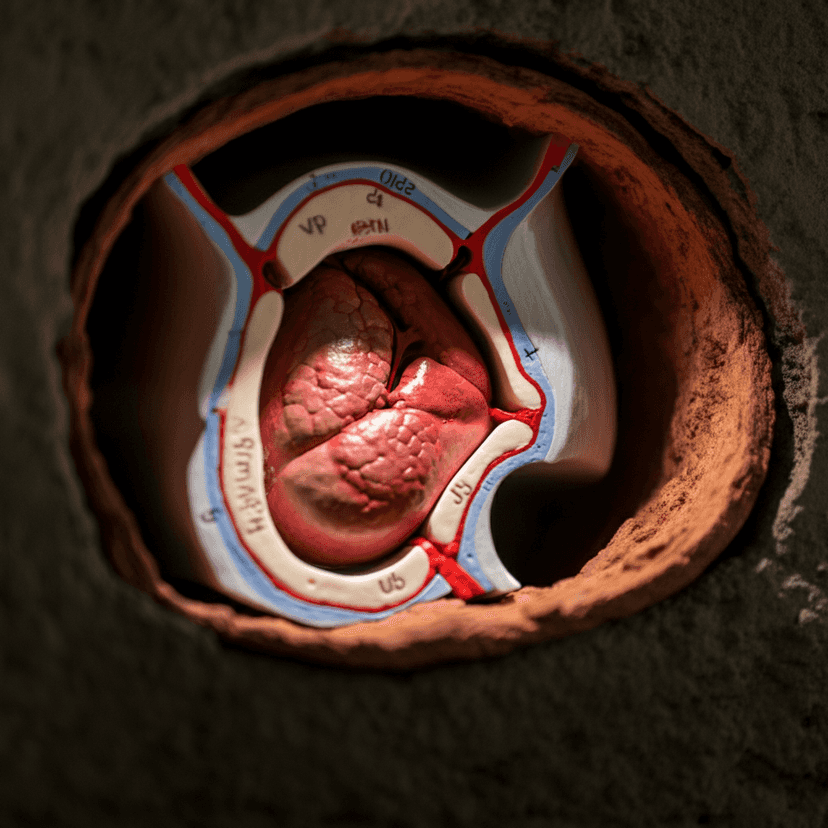ከባለፈው ዝርዝር እንደጀምር
$5500
የሜዳው ተጠቃሚ ለመምረጥ በማንበብ እርዳታ እስከ ሞልተው አስተዋወቅ?
የምስራቅ ምርመራዎችም በእኛ ተመልከቱ

በመቀየር ሕይወት የቪኤስዲ መዘጋት
Ventricular Suppal ጉድለት (VSD) በአተዋዋሪ septum ውስጥ አንድ ወይም ከዚያ በላይ ቀዳዳዎች, የታችኛው ክፍሎቹን የሚለይ ግድግዳው (ventricles) የሚለያይ ግድግዳ. VSD በጣም ከተለመደው የወንጀል ወ / ቤት የልብ ምት ውስጥ አንዱ ነው, ነገር ግን በህይወት ውስጥ በኋላ እንደሚመረመር ሊታወቅ ይችላል.
VSD መረዳት
ከግራ ventricen እና ኦክሲጂን - ከቀኝ ventricly ከግራ ventricen ደካማ የደም ethricle ደም ጋር የማይደባለቀ ደም ማፍራት ወሳኝ ሚና ይጫወታል. በዚህ ሴፕምም ውስጥ ያለው ጉድለት ደም ከግራ ወደ ቀኝ ventricle እንዲፈስ ያስችለታል, የሳንባ ግፊት መጨናነቅ እና የልብ ፓምፊንግ ውጤታማነት እንዲጨምር ያደርጋል.
የ VSD ዓይነቶች
Vsds በአ ventricular septum ውስጥ ባለው ቦታ ላይ በመመርኮዝ ይመደባሉ:
- Perimembranous VSD: በጣም የተለመደው ዓይነት, በ tricuspid እና aortic valves አቅራቢያ ባለው የሴፕተም የላይኛው ክፍል ላይ ይከሰታል.
- ጡንቻማ ቪኤስዲ: በሰፊው የታችኛው ክፍል ውስጥ ይገኛል, እነዚህ ሰዎች ብዙ ሊሆኑ እና በራሳቸው ሊዘጉ ይችላሉ.
- Inlet vsd: ወደ ventricalles ደምን ወደሚያመጣው ቫል ves ች አጠገብ ይከሰታል.
- መውጫ vsd: ከአውሮፕላን ማረፊያዎች በሚመሩበት ቫል ves ች ውስጥ ይገኛል.
የ VSD ምልክቶች
የሕመሙ ምልክቶች ክብደት እንደ ጉድለቱ መጠን እና ከግራ ወደ ቀኝ በሚወጣው የደም መጠን ይወሰናል. ትናንሽ VsDs ምንም ምልክቶች ሊያስከትሉ እና በድንገት ሊጸዱ ይችላሉ, ሰፋ ያሉ ጉድለቶች ወደ መምራት ሊመሩ ይችላሉ:
- የትንፋሽ እጥረት
- ድካም
- በተደጋጋሚ የመተንፈሻ አካላት ኢንፌክሽን
- ደካማ እድገትን እና ሕፃናትን መመገብ
የ VSD ምርመራ
VSD በተለምዶ የልብ አወቃቀር እና ተግባር ዝርዝር ምስሎችን የሚያቀርብ hecocardioge ን በመጠቀም ነው. ሌሎች የምርመራ መሳሪያዎች ኤሌክትሮ ካድሮግራሞችን (ECG), የደረት ኤክስ-ጨረር, ወይም የልብ ምት ማካተት ይችላሉ.
የ VSD ሕክምና
ሕክምናው በተበላሸው መጠን, በአከባቢው እና በሚያስችላቸው ምልክቶች ላይ የተመሠረተ ነው:
ትናንሽ ቪሾች ብዙውን ጊዜ ህክምና አያስፈልገውም እና በራሳቸው ሊዘጉ ይችላሉ.
መካከለኛ ወደ ትልልቅ Vsds እንደ substary የደም ግፊት ወይም የልብ ውድቀት ያላቸውን ችግሮች ለመከላከል የሚረዱ ቀዶ ጥገና ጣልቃ ገብነት ሊፈልግ ይችላል. ይህ በተለምዶ ክፍት የልብ ቀዶ ጥገና በሚደረግበት ጊዜ ቀዳዳውን ማስተካከልን ያካትታል.
ክፍት ቀዶ ጥገና ሳያስፈልግ ቪኤስዲውን ለመዝጋት መሳሪያን በመጠቀም ካቴተርን መሰረት ያደረጉ ሂደቶች ለአንዳንድ ጉዳዮችም ይገኛሉ.
መልሶ ማግኛ እና አስተዳደር
ከቀዶ ጥገና በኋላ ህጻናት ቶሎ ቶሎ ይድናሉ, አብዛኛዎቹ ምንም አይነት ገደብ የሌላቸው መደበኛ ህይወት ይመራሉ. የልብ ጤናን ለመቆጣጠር እና ማንኛውንም ሊሆኑ የሚችሉ ጉዳዮችን ለመከታተል የሂሊዮሎጂስት ተከታታይ ክትትሮች ወሳኝ ናቸው.
መደምደሚያ
ቪኤስዲ (VSD) ከባድ ሁኔታ ሲኖር, ብዙውን ጊዜ ከተገቢው አስተዳደር ጋር ጥሩ ትንበያ አለው. በምርመራ ቴክኒኮች እና የህክምና አማራጮች ውስጥ መሻሻል ለተጎዱት ሰዎች ውጤቶችን ማሻሻልዎን ይቀጥሉ.
4.0
90% የተገመተ ዋጋ ለገንዘብ
እኛን አስተያየታችንን?
96%
የታሰበው አስር ርቀት
19+
የቪኤስዲ መዘጋት እርሱን የቀዶ ጥገኞች
0
የቪኤስዲ መዘጋት
24+
በላይ የሚኖሩ ሆስፒታሎች
0
የተነኩ ሕይወቶች
እይታ
Ventricular Suppal ጉድለት (VSD) በአተዋዋሪ septum ውስጥ አንድ ወይም ከዚያ በላይ ቀዳዳዎች, የታችኛው ክፍሎቹን የሚለይ ግድግዳው (ventricles) የሚለያይ ግድግዳ. VSD በጣም ከተለመደው የወንጀል ወ / ቤት የልብ ምት ውስጥ አንዱ ነው, ነገር ግን በህይወት ውስጥ በኋላ እንደሚመረመር ሊታወቅ ይችላል.
VSD መረዳት
ከግራ ventricen እና ኦክሲጂን - ከቀኝ ventricly ከግራ ventricen ደካማ የደም ethricle ደም ጋር የማይደባለቀ ደም ማፍራት ወሳኝ ሚና ይጫወታል. በዚህ ሴፕምም ውስጥ ያለው ጉድለት ደም ከግራ ወደ ቀኝ ventricle እንዲፈስ ያስችለታል, የሳንባ ግፊት መጨናነቅ እና የልብ ፓምፊንግ ውጤታማነት እንዲጨምር ያደርጋል.
የ VSD ዓይነቶች
Vsds በአ ventricular septum ውስጥ ባለው ቦታ ላይ በመመርኮዝ ይመደባሉ:
- Perimembranous VSD: በጣም የተለመደው ዓይነት, በ tricuspid እና aortic valves አቅራቢያ ባለው የሴፕተም የላይኛው ክፍል ላይ ይከሰታል.
- ጡንቻማ ቪኤስዲ: በሰፊው የታችኛው ክፍል ውስጥ ይገኛል, እነዚህ ሰዎች ብዙ ሊሆኑ እና በራሳቸው ሊዘጉ ይችላሉ.
- Inlet vsd: ወደ ventricalles ደምን ወደሚያመጣው ቫል ves ች አጠገብ ይከሰታል.
- መውጫ vsd: ከአውሮፕላን ማረፊያዎች በሚመሩበት ቫል ves ች ውስጥ ይገኛል.
የ VSD ምልክቶች
የሕመሙ ምልክቶች ክብደት እንደ ጉድለቱ መጠን እና ከግራ ወደ ቀኝ በሚወጣው የደም መጠን ይወሰናል. ትናንሽ VsDs ምንም ምልክቶች ሊያስከትሉ እና በድንገት ሊጸዱ ይችላሉ, ሰፋ ያሉ ጉድለቶች ወደ መምራት ሊመሩ ይችላሉ:
- የትንፋሽ እጥረት
- ድካም
- በተደጋጋሚ የመተንፈሻ አካላት ኢንፌክሽን
- ደካማ እድገትን እና ሕፃናትን መመገብ
የ VSD ምርመራ
VSD በተለምዶ የልብ አወቃቀር እና ተግባር ዝርዝር ምስሎችን የሚያቀርብ hecocardioge ን በመጠቀም ነው. ሌሎች የምርመራ መሳሪያዎች ኤሌክትሮ ካድሮግራሞችን (ECG), የደረት ኤክስ-ጨረር, ወይም የልብ ምት ማካተት ይችላሉ.
የ VSD ሕክምና
ሕክምናው በተበላሸው መጠን, በአከባቢው እና በሚያስችላቸው ምልክቶች ላይ የተመሠረተ ነው:
ትናንሽ ቪሾች ብዙውን ጊዜ ህክምና አያስፈልገውም እና በራሳቸው ሊዘጉ ይችላሉ.
መካከለኛ ወደ ትልልቅ Vsds እንደ substary የደም ግፊት ወይም የልብ ውድቀት ያላቸውን ችግሮች ለመከላከል የሚረዱ ቀዶ ጥገና ጣልቃ ገብነት ሊፈልግ ይችላል. ይህ በተለምዶ ክፍት የልብ ቀዶ ጥገና በሚደረግበት ጊዜ ቀዳዳውን ማስተካከልን ያካትታል.
ክፍት ቀዶ ጥገና ሳያስፈልግ ቪኤስዲውን ለመዝጋት መሳሪያን በመጠቀም ካቴተርን መሰረት ያደረጉ ሂደቶች ለአንዳንድ ጉዳዮችም ይገኛሉ.
መልሶ ማግኛ እና አስተዳደር
ከቀዶ ጥገና በኋላ ህጻናት ቶሎ ቶሎ ይድናሉ, አብዛኛዎቹ ምንም አይነት ገደብ የሌላቸው መደበኛ ህይወት ይመራሉ. የልብ ጤናን ለመቆጣጠር እና ማንኛውንም ሊሆኑ የሚችሉ ጉዳዮችን ለመከታተል የሂሊዮሎጂስት ተከታታይ ክትትሮች ወሳኝ ናቸው.
መደምደሚያ
ቪኤስዲ (VSD) ከባድ ሁኔታ ሲኖር, ብዙውን ጊዜ ከተገቢው አስተዳደር ጋር ጥሩ ትንበያ አለው. በምርመራ ቴክኒኮች እና የህክምና አማራጮች ውስጥ መሻሻል ለተጎዱት ሰዎች ውጤቶችን ማሻሻልዎን ይቀጥሉ.



























